This Ham Jambalaya is a perfect dish for using leftovers. Easy to make in one pot, and comforting on chilly days. Delicious topped with feta!
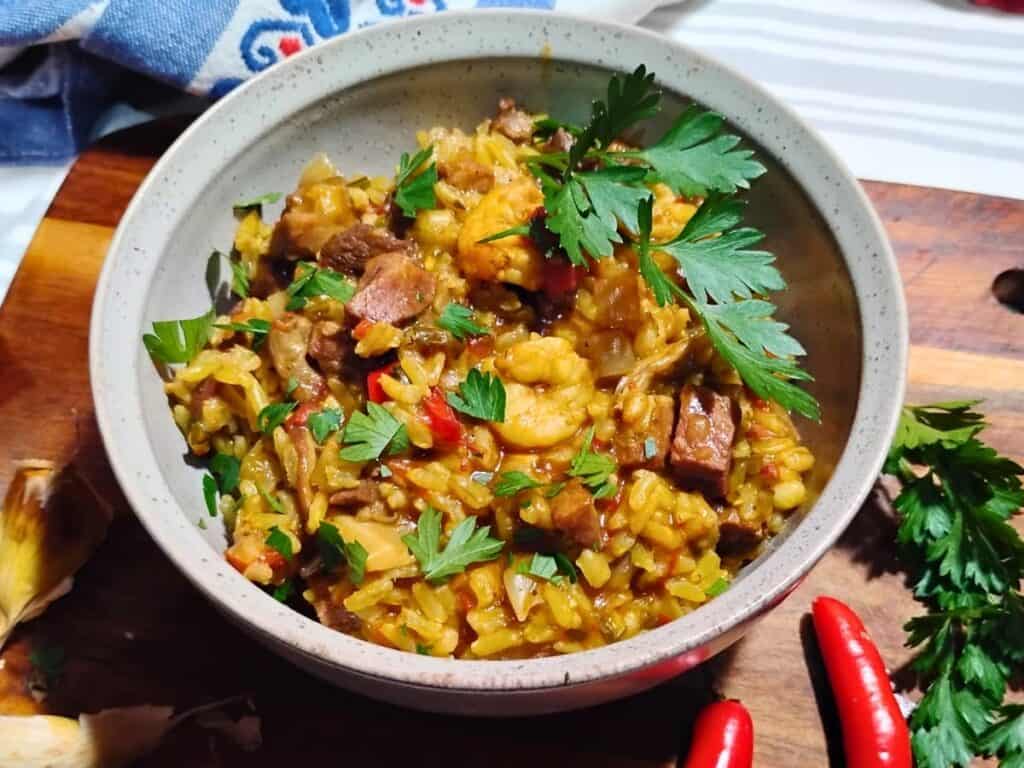
This jambalaya dish is a fabulous and easy one-pot rice meal that transforms leftover ham into a new delicacy. It’s based on creole jambalaya rice recipes, but with some variations. This is one of my favorite leftover ham recipes and it is so comforting on a chilly night.
One-pot ham jambalaya is delicious on its own when served in a bowl. But it’s even better topped with cheese and a crusty sourdough bread, cornbread, or a salad on the side. Shrimps are optional, but I highly recommend adding them for that Louisiana Jambalaya touch and awesome flavor and texture. If you’re looking to do something with your leftover ham, you’re at the right place, let’s cook up some deliciousness for dinner tonight!
If you love rice dishes, you must try my fantastic Mushroom Risotto and Stuffed Pepper Recipe! And if you love spicy foods, try my fermented pepper recipes, Fermented Jalapenos, Fermented Chili Paste, and Cantaloupe Hot Sauce. You might also like the amazing Zucchini Ikra, and Zwiebelkuchen (onion quiche). It’s fantastic!
- One Pot Ham Jambalaya, An Easy Recipe For Using Leftovers
- What is Jambalaya?
- Why You’ll Love One-Pot Ham Jambalaya
- Tips And Substitutions For Making The Best One-Pot Ham Jambalaya
- How To Make The Best One-Pot Ham Jambalaya
- Storage
- Your Questions Answered
- Enjoy This Delicious One-Pan Ham Jambalaya
- Other Recipes You Might Like
- Pin This Recipe For Later
- Shop This Post
This post contains affiliate links. As an Amazon affiliate, I make a small commission at no extra cost to you if you make a qualifying purchase. See my full disclosure here.
One Pot Ham Jambalaya, An Easy Recipe For Using Leftovers
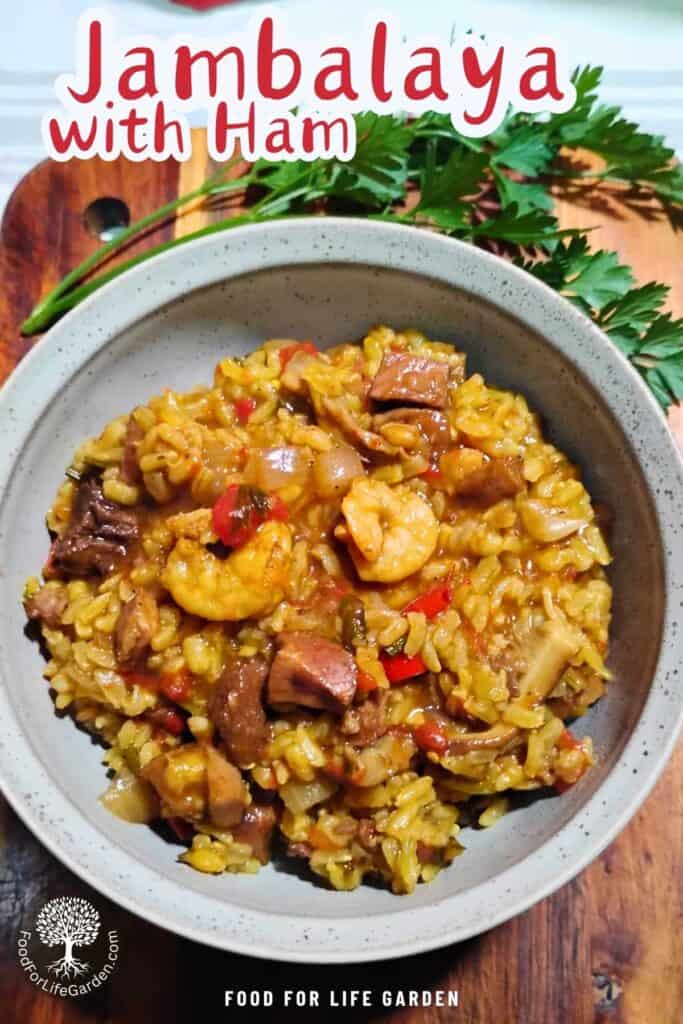
I originally found a recipe for ham jambalaya in an old homesteading cookbook about 35 years ago. I don’t remember which cookbook, but it was a perfect and delicious recipe for using leftover ham. So I saved the recipe and altered it a bit over time and I usually vary my ingredients depending on what’s in the pantry and freezer. It’s always delicious. And I love topping it with my homemade feta cheese!
I prefer to cook large bone-in country hams, because they are just so much better than processed cooked ham. However, it yields a lot of meat and there are always leftovers. This is actually a blessing though, because leftover ham is delicious in so many recipes. Soups, chowders, stews, casseroles, quiche, omelette, salad, sandwiches… The list is long and so there is no reason to not cook a big ham, chop the leftovers and freeze them for delicious new meals later.
I recently cooked one of my last homemade hams (I’ll post all about curing your own ham sometime, stay tuned and get on my mailing list if you’d like to get notified!). So this ham was whole, but it was from a Kune kune x American guinea hog cross and so it was not immensely huge, but certainly big enough for several meals. I froze about 4 quarts of chopped ham for later.
One of those bags went into this jambalaya along with some shrimps and lots of veggies from the garden. It’s November now, but I still had a few rescued fresh tomatoes and peppers, and my parsley and celery are still green in the garden. But this can also be made with canned tomatoes and frozen parsley and peppers.
What is Jambalaya?

The background and history of jambalaya is as mixed and diverse as the dish itself. With it’s many cultural influences, Louisiana has an eclectic cuisine that evolved from the blending of the flavors of it’s many cultures.
Jambalaya is a one pan rice dish that has become famous for Louisiana fare. It even inspired a popular country music hit. Incidentally, this was the first song that I learned to play on my bass many years ago and accompanied a guitar-playing friend at an open mic. That was a long time ago! I played many gigs after that, covering many genres, but I will always have a soft spot for the Jambalaya song and the dish.
Louisiana has a rich cultural history and is known for its african, creole, and cajun foods. Louisiana cuisine has primarily West African, Spanish, and French influences. According to wikipedia (an interesting read!)West Africans had jollof in their home country, the Spanish had paella, and the French had pilau. In Louisiana, the various original recipes were melded, with the addition of other minor influences, such as Caribbean. And so it transformed into the version we now know as Jambalaya. A rice dish mixed with meat and/or seafood and vegetables.
Creole vs. Cajun Jambalaya

Jambalaya can be either creole or cajun, and there are also a few other versions that are not as well known. Creole has tomatoes and cajun doesn’t. The creole version, also known as ‘red’ Jambalaya, is usually more wet or saucy, while the cajun version, or ‘brown’ jambalaya, is drier, like a pilaf. The different versions are mostly region specific. Around Louisiana you’ll find the creole version to dominate while west and middle Louisiana cooks up mostly the cajun version.
Both versions start with the ‘trinity’ of onions, celery, and green bell peppers. Other vegetables can be okra, corn, carrots, chilis and garlic. I like to include mushrooms, which is not mentioned anywhere, but I love adding them. I think you could add any vegetable you like that would go well with the rest of the flavors. I’m thinking beans, zucchini, snow peas, or beets.
Why You’ll Love One-Pot Ham Jambalaya
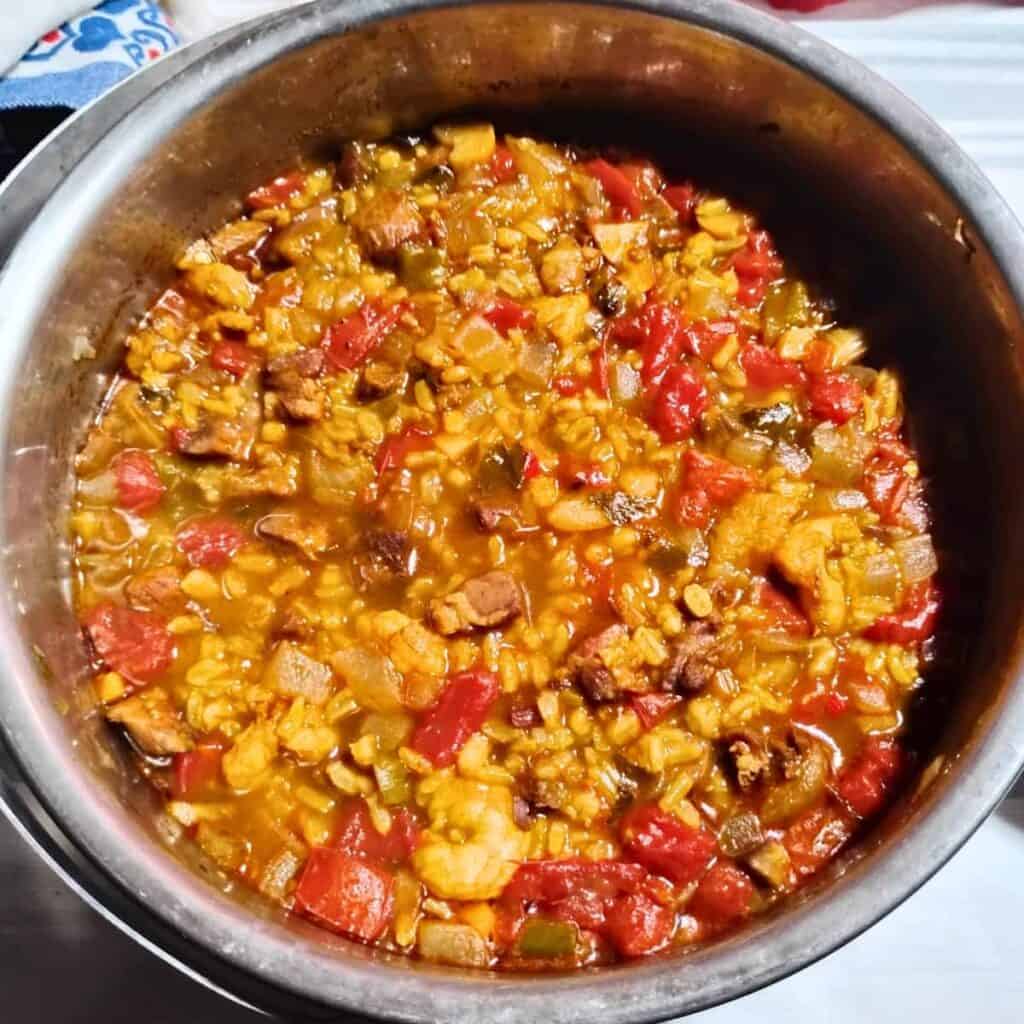
- This is so easy to make and only requires one sauce pot or dutch oven.
- Jambalaya tastes fantastic!
- It is nutritious if you use soaked brown rice and homegrown or organic vegetables.
- Great for using leftover ham after Easter or Christmas dinner.
- This is a great dish to take to a potluck or serve at a game-day party too!
- It’s wonderful comfort food for chilly days!
- It’s versatile. Add seasonal vegetables or any meat you have leftovers of. Normally Jambalaya starts with fresh meat such as chicken and then Andouille sausage is added along with shrimps or crayfish. But people in the country always used what they had and that is what I do. I have not heard of a law against using duck, turkey, pork, goat, beef, or game if that is what’s in your freezer.
- Jambalaya is nutritious. You’ll get a good dose of protein from the meat, some iodine and marine minerals from the seafood. Add to that vitamins and minerals from vegetables, fiber from the whole grain rice or other grain, and inflammation fighters and anti-oxidants from vegetables and spices. Turmeric, garlic, parsley and thyme are great for brain health too.
Tips And Substitutions For Making The Best One-Pot Ham Jambalaya

- You can leave out the shrimps or substitute with crayfish, fish, or crab. I made it with fresh caught salmon in the past and it was delicious.
- I often replace part of the rice with hulled barley, because I love the chewy texture. You could also use other grains if you like.
- Use canned tomatoes instead of the fresh ones. A small can (14 oz) would work fine.
- I love using lots of spices, but feel free to simplify, just don’t leave out the cloves, they make this dish special. I like to add some anti-inflammatory spices and I love adding spirulina for a more sea-foody flavor and its health benefits.
- This is wonderful topped with fresh chopped garlic, fresh ground pepper and feta cheese. A dollop of sourcream would be very nice too, I imagine, and grated cheddar cheese is also very good. I’m not going for authenticity here, lol. Just making a delicious homemade meal adjusted to my preferences. So feel free to do the same.
- When I reheat my leftovers, I like to drop an egg into it. More protein and it tastes so good. It is best when it’s medium done in my opinion.
- Soak your rice for better absorbance of the nutrients and to reduce phytic acid. Just put it in a bowl, pour over some warm water with vinegar, lemon juice, sourdough, or whey. Then let it sit overnight or up to 24 hours.
How To Make The Best One-Pot Ham Jambalaya
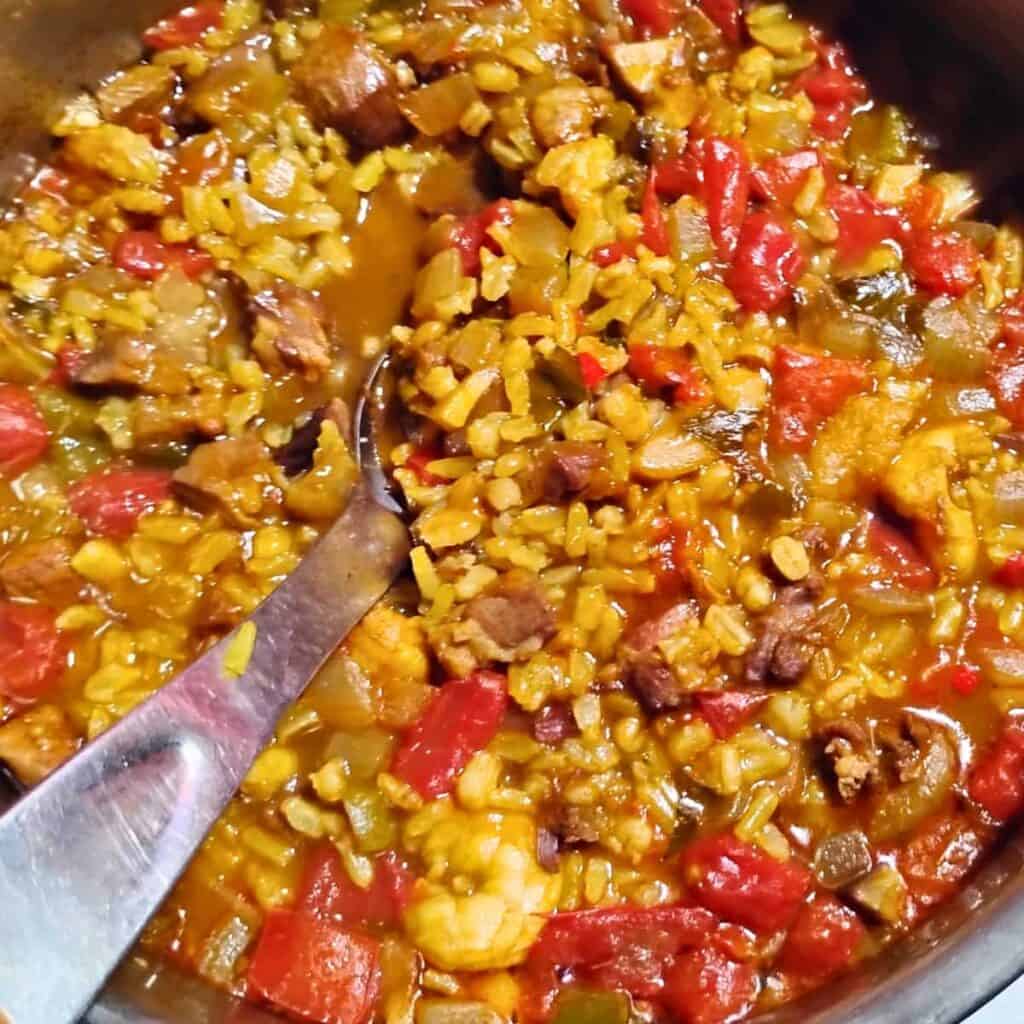
My recipe is for a creole style Jambalaya and includes tomatoes. And it includes not so common ingredients that I choose to add because they are beneficial for my health. And I add some because it is what’s available to me, and a preference. My aim is to cook with things that I can grow and raise myself. But I did include the shrimps, because I love shrimps and saltwater seafood is so good for you. You do not have to add them and can substitute any other seafood you like or are able to catch.
Equipment
5 quart dutch oven or 4-5 quart pot – I love cooking rice dishes in a heavy pot and my favorite to use is a cast iron Dutch oven, but I used a 4 qt camping pot this time. Here is a nice 5.5 qt enameled dutch oven with a non-stick, non-toxic ceramic coating.
Knife + Cutting Board – for chopping the vegetables and ham.
Large spoon – for stirring the ingredients.
A bowl with lid for soaking the rice
Ingredients
I like to mention how important it is to choose organically grown produce and ingredients whenever possible. Conventionally grown food is most often treated with toxic pesticides and other chemicals meant to prolong shelf life. And in todays world, genetically modified produce and ingredients are the norm.
An organic label ensures that it will be non-GMO, and free from most harmful chemicals (the humidity sprayer in the vegetable section of the grocery stores also contains chemicals, so do watch for that)! Besides that, in most cases, organically grown food, especially when using regenerative farming practices, has much better nutritional value. It is food that will nourish and support our bodies.
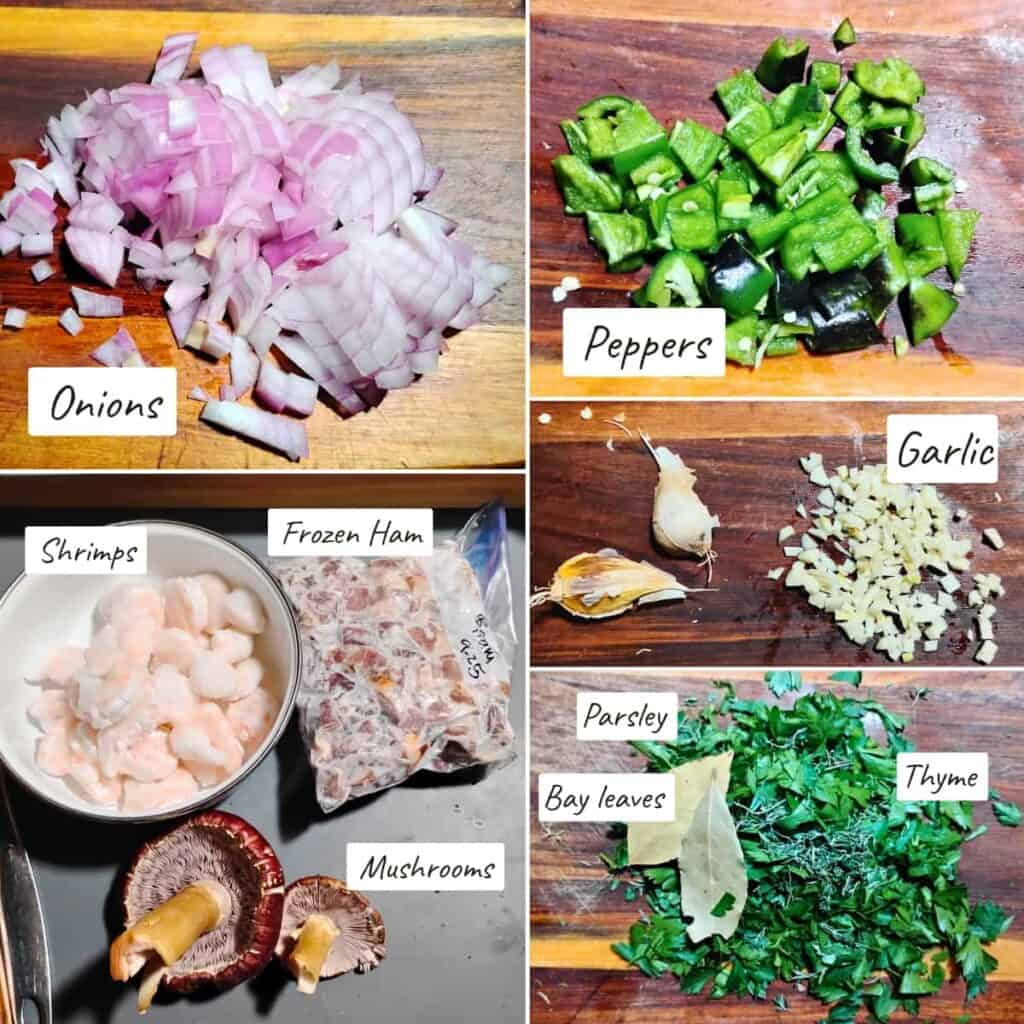
Fat – Any fat will do, lard, tallow, chicken grease, butter, or oil. If you’re choosing oil, don’t overheat it, especially olive oil. I do recommend that you use an anti-inflammatory oil, such as avocado oil or coconut oil. Most oils in the grocery store are inflammatory!
Onions, chopped – Any onions will work. I used the ones from my garden that I don’t know what variety they are. Onions are part of the ‘trinity’, the must-haves for authentic jambalaya.
Green pepper, chopped – Also part of the trinity of vegetables that are a cornerstone of authentic jambalaya.
Celery, chopped – Part three of the ‘trinity’. Essential for the authentic jambalaya, but don’t sweat it if you don’t have any. Celery leaves count too.
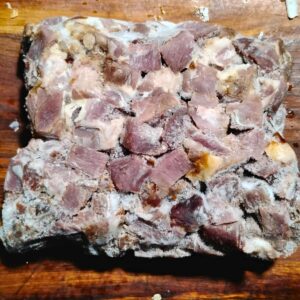
Ham, cubed – Fresh or frozen.
Garlic, chopped – Essential in my jambalaya! I also sprinkle some raw chopped garlic over my finished jambalaya serving.

Parsley, chopped
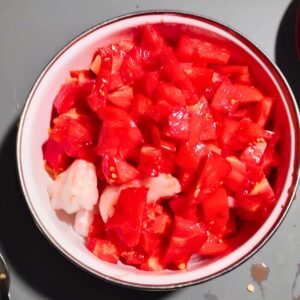
Tomatoes, chopped – Always part of the creole jambalaya but not on the cajun version. It is in my recipe!
Shrimps, Crayfish, or Crab – Try your best to source wild-caught seafood. Farmed seafood is not very healthy, sometimes genetically modified and often fed a manufactured feed that often includes soy and corn, and may contain synthetic food coloring. They are given antibiotics to avoid disease due to overcrowding, and can also be subject to other pesticides.
Chicken or fish stock, or ham, beef, pork, or vegetable stock – Use any rich stock you have such as meat broth or bone broth, or a vegetable based broth. Fish broth from bones, heads and fins are wonderfully nutritious and would work really well in this dish.
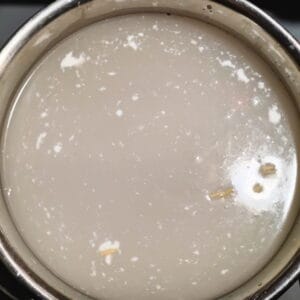
Rice soaking in whey water for 24 hours.
Brown rice (or other grain, such as hulled barley) – I often mix brown jasmine rice and hulled barley (not pearled) to get a chewy texture. This time I actually didn’t have enough rice and substituted with half a cup of barley. Einkorn, spelt, emmer or khorasan are also great for grain bowls like this, but it will be different in texture and flavor. Barley also has high beta-glucan content, which lowers serum cholesterol. My favorite rice for these kinds of dishes is brown Jasmine rice.
Tip: Soak your rice for better absorbance of the nutrients and to reduce phytic acid. Just put it in a bowl, pour some warm water with vinegar, lemon juice, sourdough, or whey over it and let it sit overnight or up to 24 hours.

1-2 cups Mushrooms, chopped (optional) – ok, I’m a mushroom fan! And I grow my own so I have plenty whenever I want some, which is often. I love mushrooms in this dish and included them in the recipe, because they taste awesome in this jambalaya.
Spices and Herbs:
Thyme, dried or fresh
Cloves
2 Bayleaves
Turmeric – famous for it’s anti-inflammatory benefits, but it does much more. I like to add it often to my cooking. Learn more about the health benefits of turmeric in my posts fermented turmeric and how to make turmeric tincture.
Smoked Paprika – you can use regular if you’re including smoked ham or smoked sausage.
Ginger paste or dried ginger – I used my fermented ginger paste, but if you have dried ginger, use that or grate a piece of fresh and add a couple of teaspoons.
Pepper – I recommend freshly ground. Piperine in pepper is an active ingredient that can help with absorbance of other beneficial compounds in foods. It’s famous for helping with absorbance of turmeric’s beneficial constituents, but piperine dissipates soon after grinding and so it’s always best to grind it fresh at point of use.
Bluegreen spirulina – This works two ways! First, I like to add it to my food for its many health benefits, and secondly, it enhances the seafood flavor of this jambalaya. I added a teaspoon to the dish and then I add another half teaspoon to a serving when I go to eat it.
Cayenne powder (or 2-3 spicy cayenne or serrano peppers) – I used fresh serranos this time.
Instructions
Optional: The day before soak your rice in whey or in water with some sourdough, vinegar, or lemon juice to reduce phytic acid and enhance absorption of nutrients. Drain before using.
Heat the fat in the dutch oven.

Add the ‘trinity’ onions, celery, and peppers and sautè for 5 minutes. If you’re using fresh hot peppers, you can include them too.
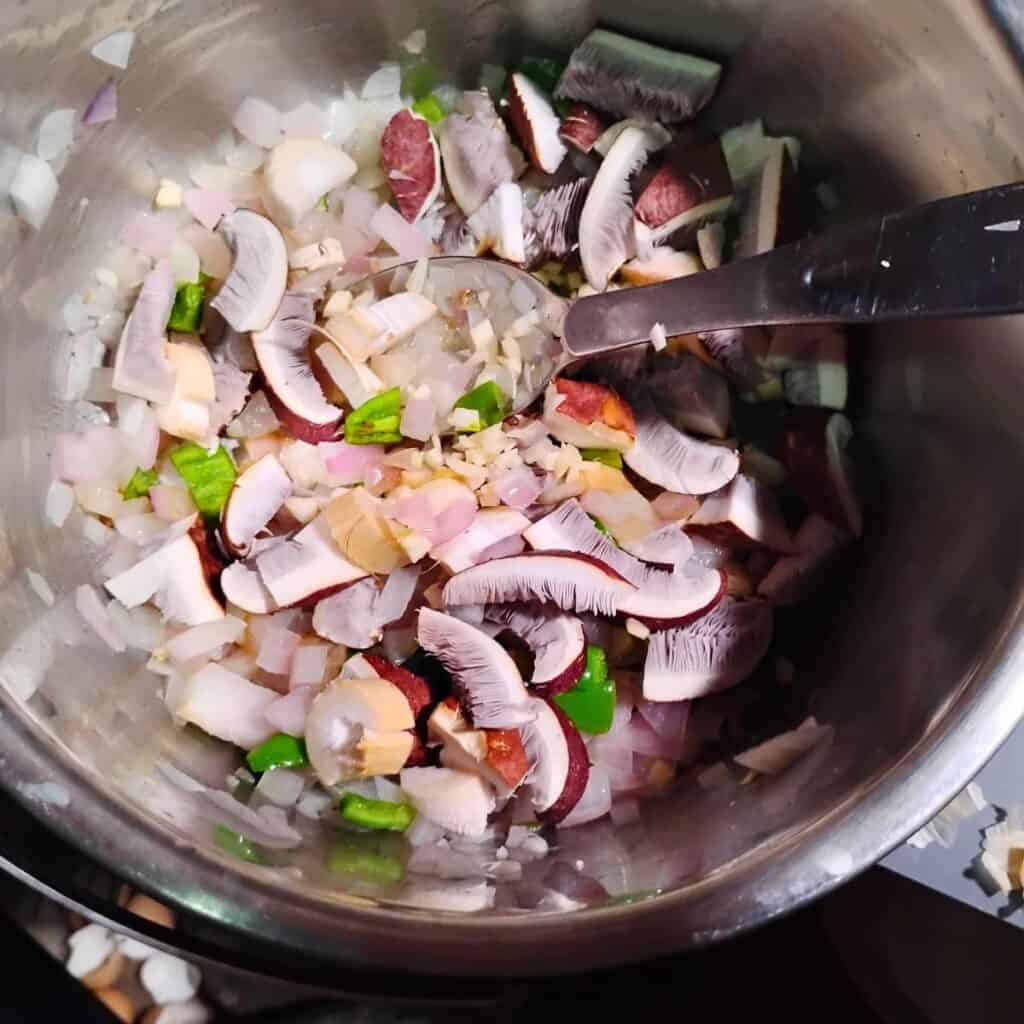
Dump in the mushrooms and sautè for 5 more minutes.
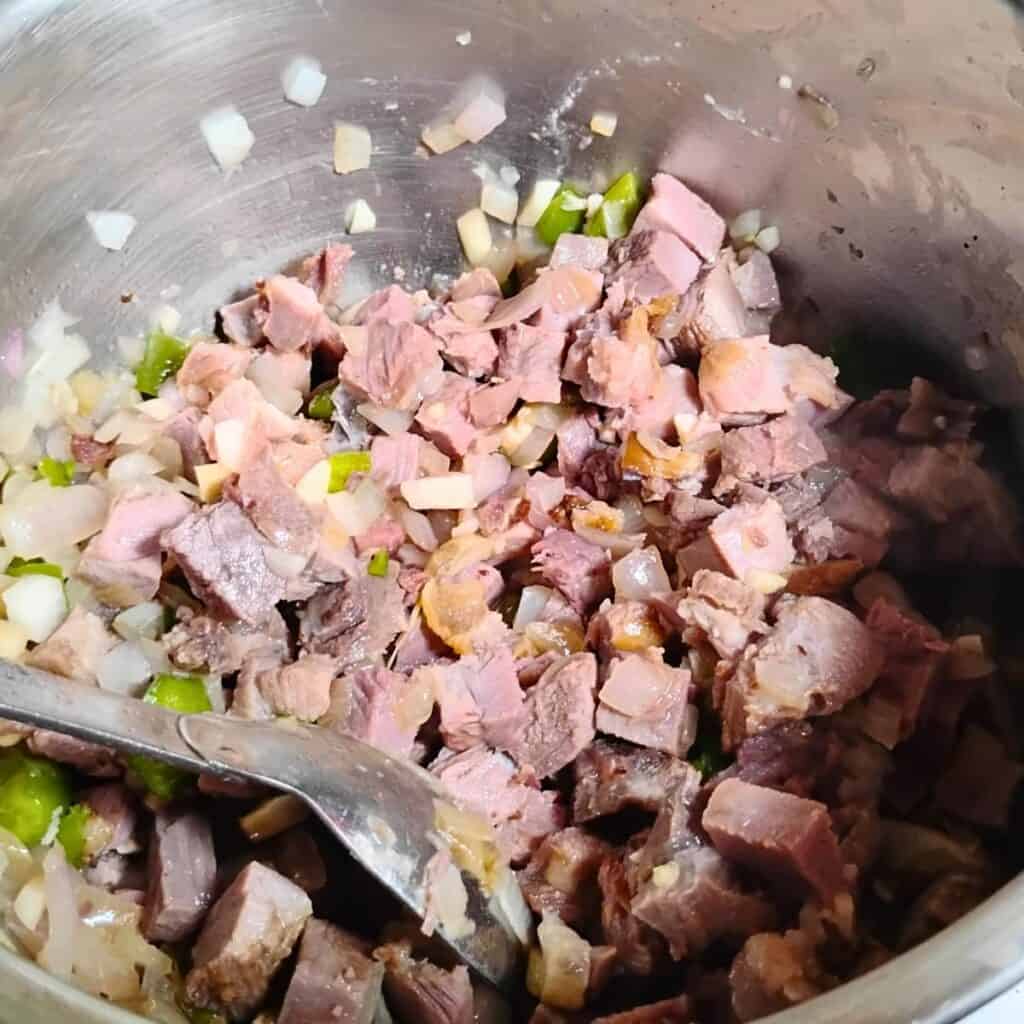
Add the ham and stir it in.
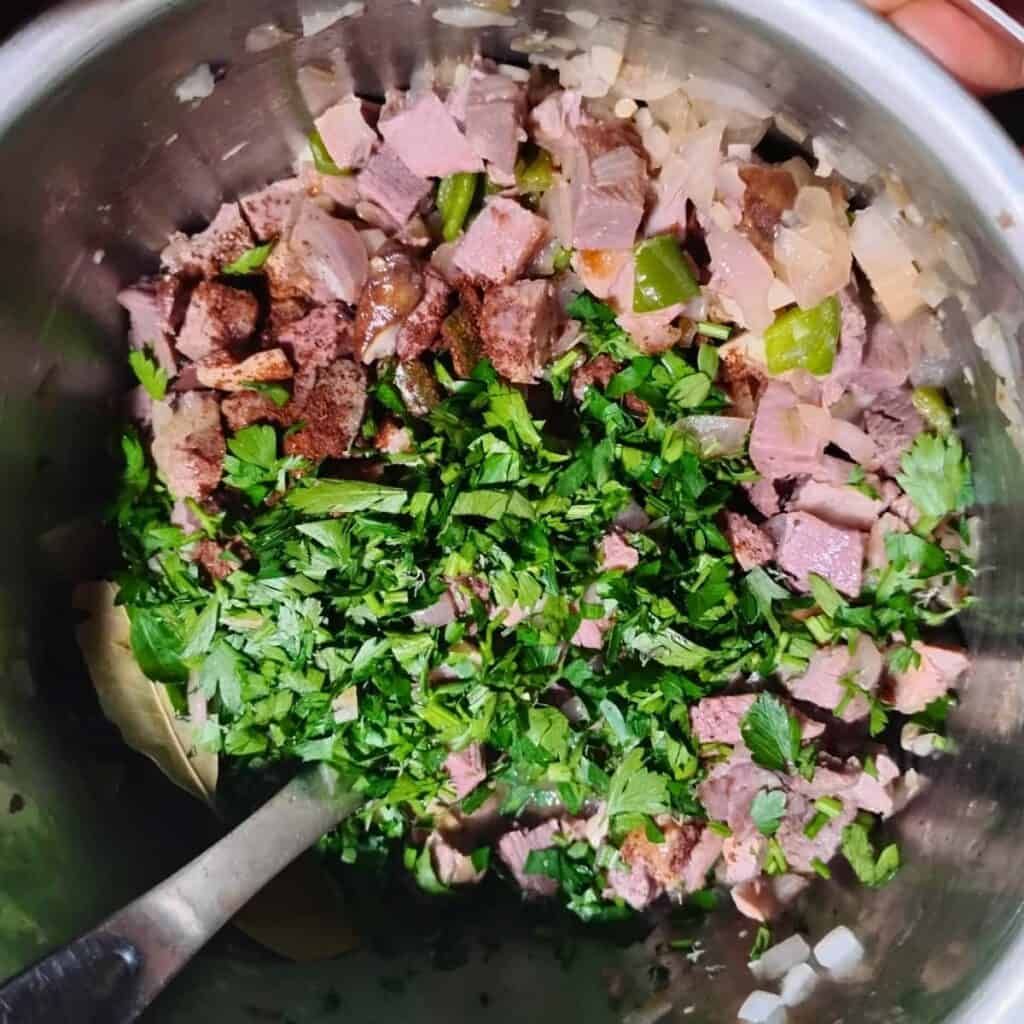
Add the garlic, herbs, and spices, stir in and saute for another minute.
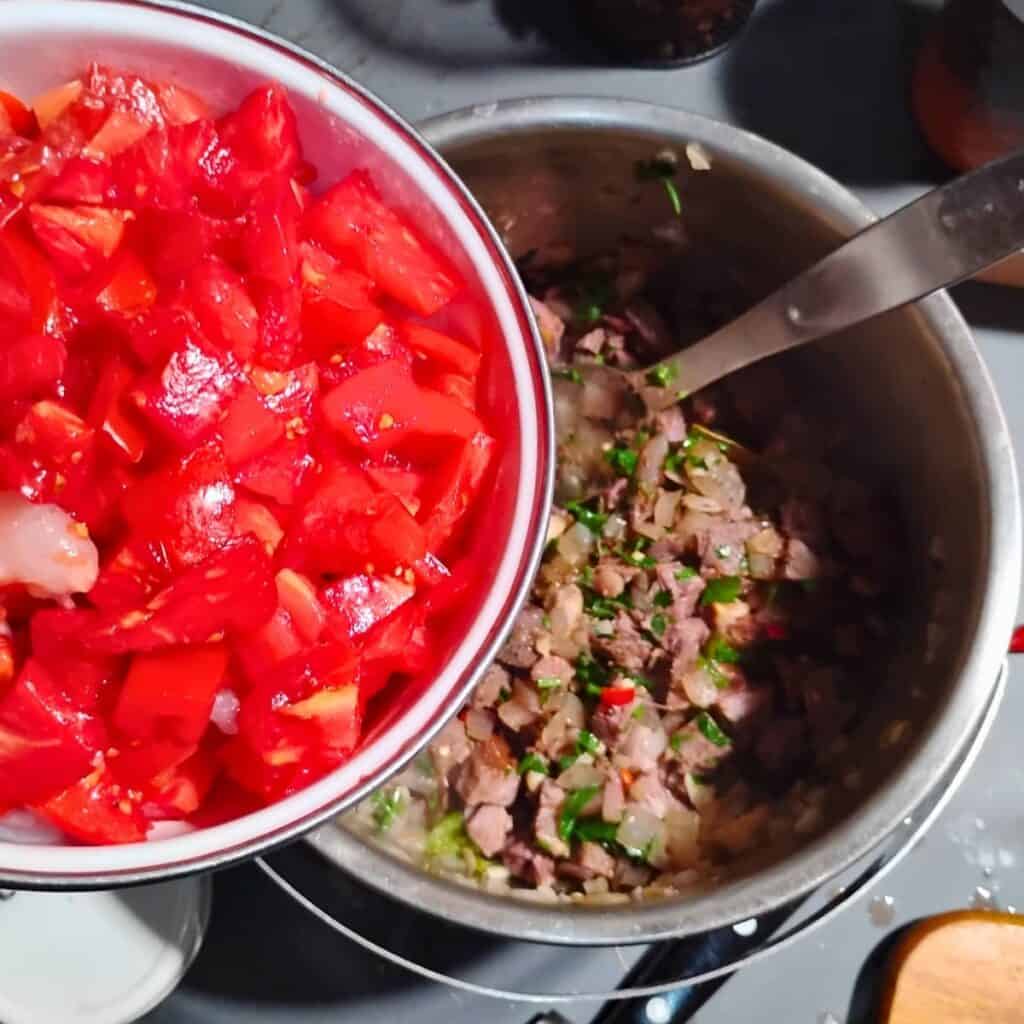
Dump in the tomatoes, shrimps, and any other add-ons you chose to use.
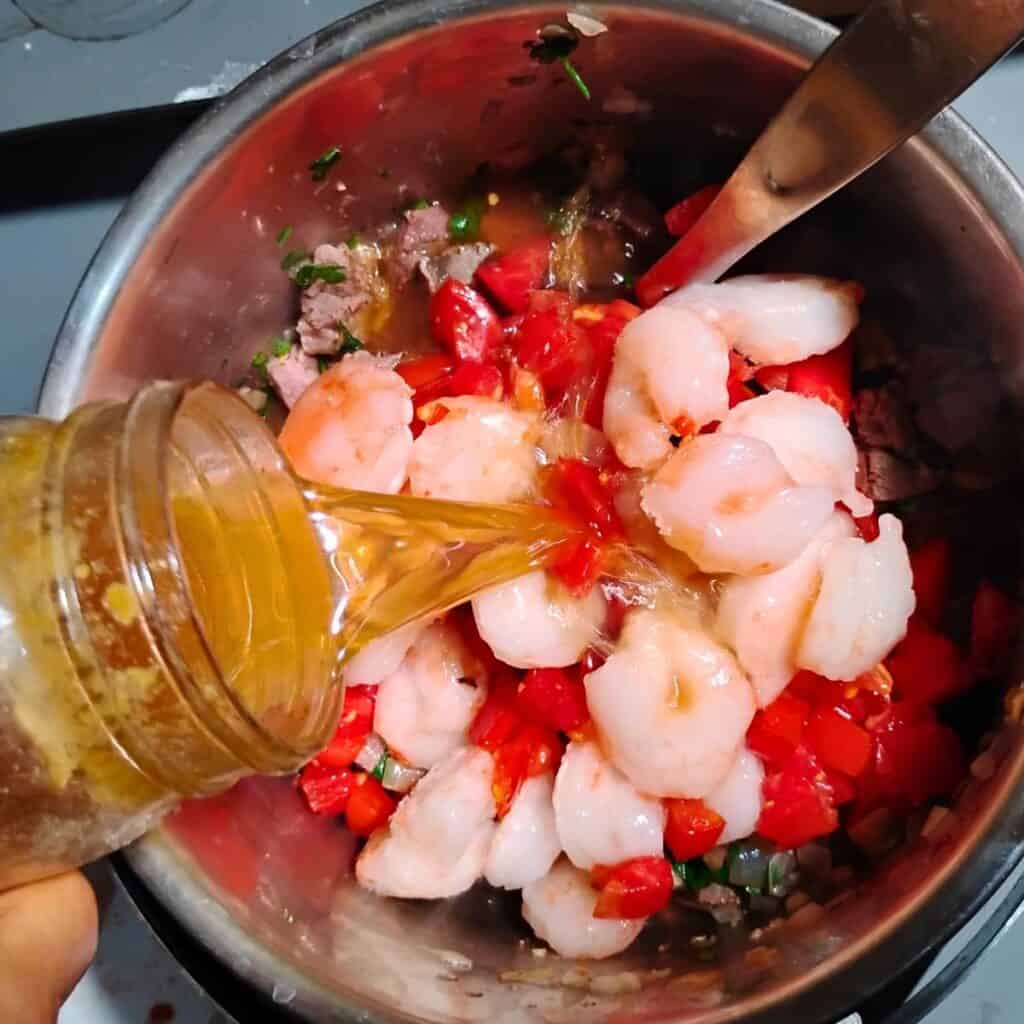
Add the soup stock and rice.

You shouldn’t need any salt if you’re using a country ham, but otherwise, taste the broth and add a bit of salt if needed and more cayenne if it’s not spicy enough for you.
Stir well, cover, bring to a simmer, stir again and then cook on low heat for 45 minutes or until your grains are as soft as you like them.
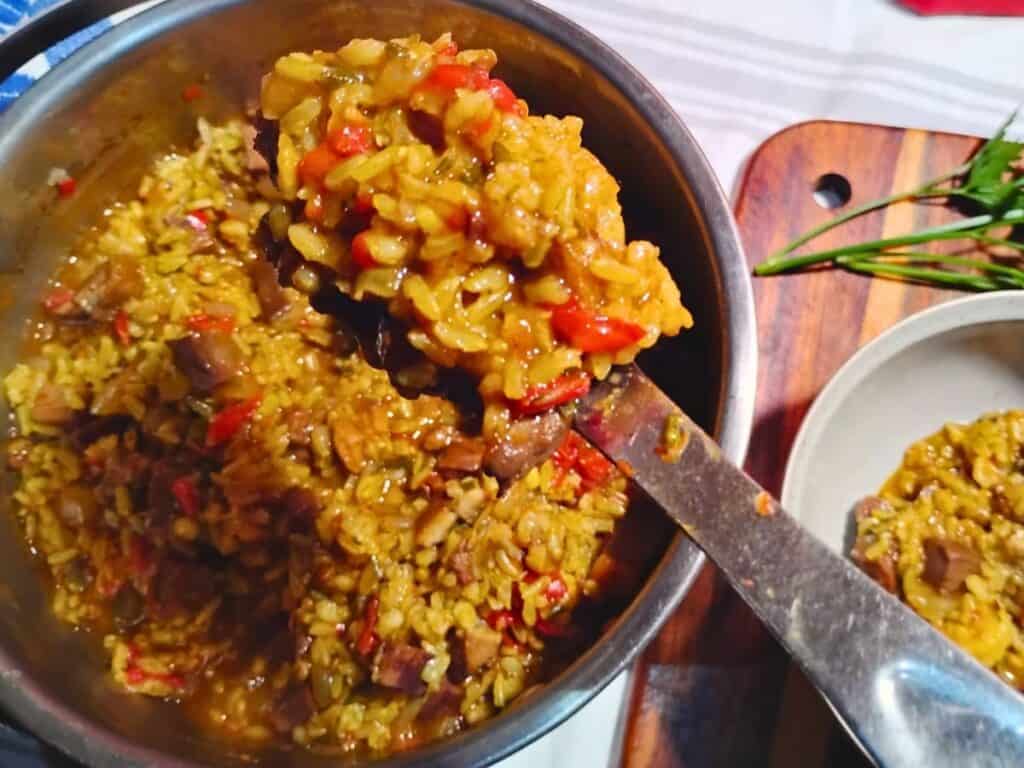
Serve as is or with crusty bread, corn bread, or a side salad. I love to top mine with fresh chopped garlic, fresh ground pepper, some parsley and grated cheddar cheese or homemade feta cheese. Sooo good!
Storage
Chill the leftovers quicker by placing the pot in a cold water bath and stirring a few times. This will cool it down faster and help to prevent growth of bad bacteria in the seafood. You could also spread it on a baking sheet to cool quickly.
You can then store this in the refrigerator for 3-4 days. (I go longer, but that is not recommended).
You can also freeze the jambalaya for up to 3 months in an airtight container or bag, once it’s completely cooled. Then defrost it in the refrigerator when you want to use it.
Your Questions Answered
What are the different types of Jambalaya?
The main types are creole and cajun jambalaya. In the New Orleans area the creole jambalaya is most common. It is more saucy and includes tomatoes. It is also referred to as ‘red’ jambalaya.
In the rural regions of mid and west Louisiana, a cajun jambalaya is preferred. This is also called ‘brown’ jambalaya. It does not include tomatoes and often uses locally available meat, game, and crayfish. This jambalaya is more dry, kind of like a pilaf.
Enjoy This Delicious One-Pan Ham Jambalaya

I sure hope you’ll give this delicious dish a try! It’s so easy and simple and it makes a satisfying meal anytime. You’ll love how versatile this is and how you can add any kind of vegetables or meats, depending on what you have. You can start with fresh meat too if that is your preference. This is one of those great recipes to have on hand for when you have leftovers to do something with. I am certain that you’ll love this fantastic dish! Enjoy!
Have you made this delicious Jambalaya recipe? I’d love to get your feedback and your ⭐⭐⭐⭐⭐ rating! And I’d love to hear your favorite ways to use leftover ham. And please don’t hesitate to ask in the comments if you have any questions!
Join the Food For Life Garden Community for more great recipes and homestead tips and ideas. I’m always adding new content. Don’t miss any new posts and learn more about my off-grid farm life.
Other Recipes You Might Like
Mushroom Risotto – delicious gourmet flavored rice dish that’s easy to make and it’s a perfect way to highlight the rich flavor of mushrooms.
Tabouli Salad – a delicious cold salad or meal, made gluten-free with quinoa and packed with nutrition and health benefits.
Healthy Stuffed Peppers With Vegetable Gravy – These healthy stuffed peppers are easy, gluten-free, and delicious, but they become extraordinary with my fantastic garden vegetable sauce!
Hearty Mushroom Chowder – A delicious, rich and flavorful chowder that can easily be adapted to any ingredients you have in your pantry!
Zwiebelkuchen a German onion pie – Delicious German fall tradition. Make some today, you won’t regret it!
Fermented Chili Paste – Here is a great way to preserve your end-of-the season harvest of green peppers. This paste will last all year in your refrigerator to use as a condiment, seasoning, or topping.
Fermented Jalapenos – Spicy, Easy, Tasty, Convenient. Keep a jar of sliced probiotic pickled jalapenos on hand for every day use.
Fermented Hot Sauce With Cantaloupe – How to make a delicious fermented hot sauce that is great with meat, fish, eggs and on sandwiches. What a great way to use some cantaloupe and spicy peppers.
Foraged Wild Weeds Pesto Recipe – Make a delicious Pesto with dead nettles and other wild weeds with this guide to foraging wild greens.
Salt-cured herbs – Preserving delicate herbs for the cold season, using either fermentation or salt-curing. Keep a jar of your favorite herbs in the refrigerator. It preserves the fresh flavor and nutrients for a year or more.
Grow mushrooms at home in your garden This is one of the most rewarding experiences in wood chip gardening. Grow your own mushrooms intentionally. It’s easy and they taste so delicious!
Pin This Recipe For Later

Shop This Post
5 quart dutch oven
4 qt camping pot
5.5 qt enameled dutch oven
Knife + Cutting Board
Brown jasmine rice
Hulled barley
Bluegreen spirulina
Redmond’s Real Salt
Himalayan pink salt

How To Make The Best One-Pot Ham Jambalaya
Equipment
- A dutch oven or 4-5 quart pot.
- knife
- Cuttingboard
- A bowl or pot with lid for soaking the rice
Ingredients
- 2 Tbsp Lard
- 2 Onions chopped
- 1 Pepper chopped
- 1 cup Celery chopped
- 1 lb Ham cubed
- 2-3 cloves Garlic chopped
- 3 Tomatoes chopped
- 1-2 cups Shrimps Crayfish, or Crab
- 2 cups Mushrooms chopped (optional)
- 1 qt Chicken or fish stock or ham, beef, pork, or vegetable stock
- 2 cups Brown rice or other grain, such as barley or a mix of grains,
Spices and Herbs
- ¼ cup Parsley, fresh, chopped or 2 tbsp dried or 2 tbsp dried
- 1 tsp Thyme, fresh or ½ tsp dried
- ½ tsp Cloves powder
- 1 tsp Turmeric turmeric powder
- 1 tsp Smoked paprika powder
- 1-2 tsp Ginger paste or ½-1 tsp dried powder
- 1 tsp Bluegreen spirulina
- 1 tsp Cayenne or 2-3 spicy cayenne or serrano peppers
- 2 Bay leaves
- 1 tsp Pepper
- Sea salt to taste
Instructions
- Optional: The day before soak your rice in water with some whey, sourdough, vinegar, or lemon juice to reduce phytic acid and enhance absorption of nutrients. Drain before using.
Making the Jambalaya
- Heat the fat in the dutch oven.
- Add the 'trinity' onions, celery, and peppers and sauté for 5 minutes. If you're using fresh hot peppers, you can include them too.
- Dump in the mushrooms and sauté for a few minutes to brown.
- Add the ham and mix in.
- Add the garlic, herbs, and spices, stir and sauté for another minute.
- Dump in the tomatoes, shrimps, and other add-ons.
- Add the soup stock and rice.
- You shouldn’t need any salt if you’re using a country ham, but otherwise, taste the broth and add a bit of salt if needed and more cayenne if it’s not hot enough for you.
- Stir well, cover, bring to a simmer, stir again and then cook on low heat for 45 minutes or until your grains are soft.
- Serve as is or with crusty bread, corn bread, or a side salad. I love to top mine with fresh chopped garlic, fresh ground pepper, some parsley and homemade feta cheese. Sooo good!
Storage
- Chill the leftovers quicker by placing the pot in a cold water bath and stirring a few times to prevent growth of bad bacteria in the seafood, or spread it on a baking sheet to cool quickly.
- You can then store this in the refrigerator for 3-4 days. (I go longer, but, but that is not recommended).
- You can also freeze the jambalaya for up to 3 months in an airtight container or bag, once it’s completely cooled. Then defrost it in the refrigerator when you want to use it.
Notes
Tips And Substitutions For Making The Best One-Pot Ham Jambalaya
- You can leave out the shrimps or substitute with crayfish, fish, or crab. I made it with fresh caught salmon in the past and it was delicious.
- I often replace part of the rice with hulled barley, because I love the chewy texture. You could also use other grains if you like.
- Use canned tomatoes instead of the fresh ones. A small can (14 oz) would work fine.
- I love using lots of spices, but feel free to simplify, just don’t leave out the cloves, they make this dish special. I like to add some anti-inflammatory spices and I love adding spirulina for a more sea-foody flavor and its health benefits.
- This is wonderful topped with fresh chopped garlic, fresh ground pepper and feta cheese. A dollop of sourcream would be very nice too, I imagine, and grated cheddar cheese is also very good. I’m not going for authenticity here, lol. Just making a delicious homemade meal adjusted to my preferences. So feel free to do the same.
- When I reheat my leftovers, I like to drop an egg into it. More protein and it tastes so good. It is best when it’s medium done in my opinion.
- Soak your rice for better absorbance of the nutrients and to reduce phytic acid. Just put it in a bowl, pour over some warm water with vinegar, lemon juice, sourdough, or whey. Then let it sit overnight or up to 24 hours.

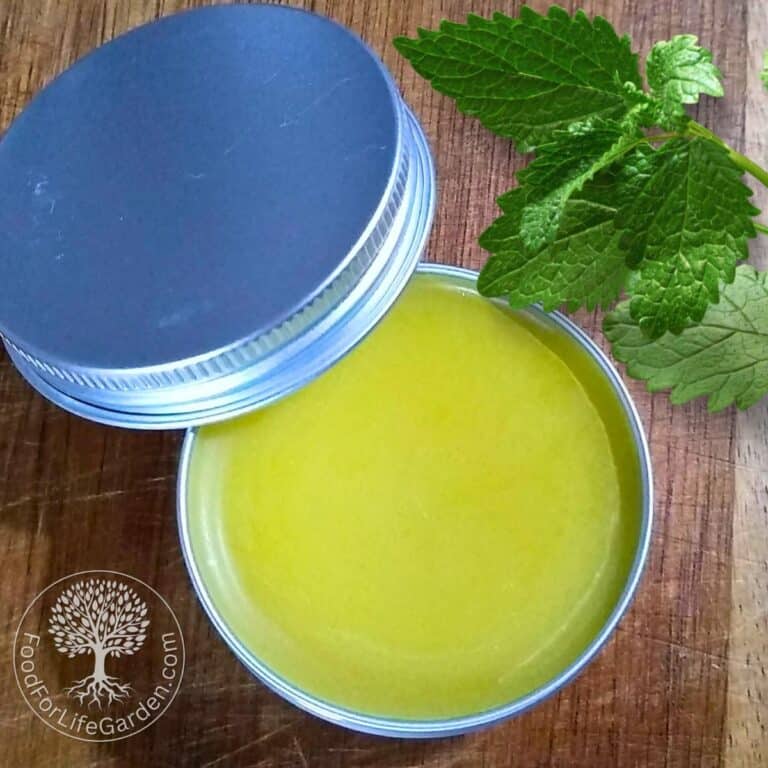
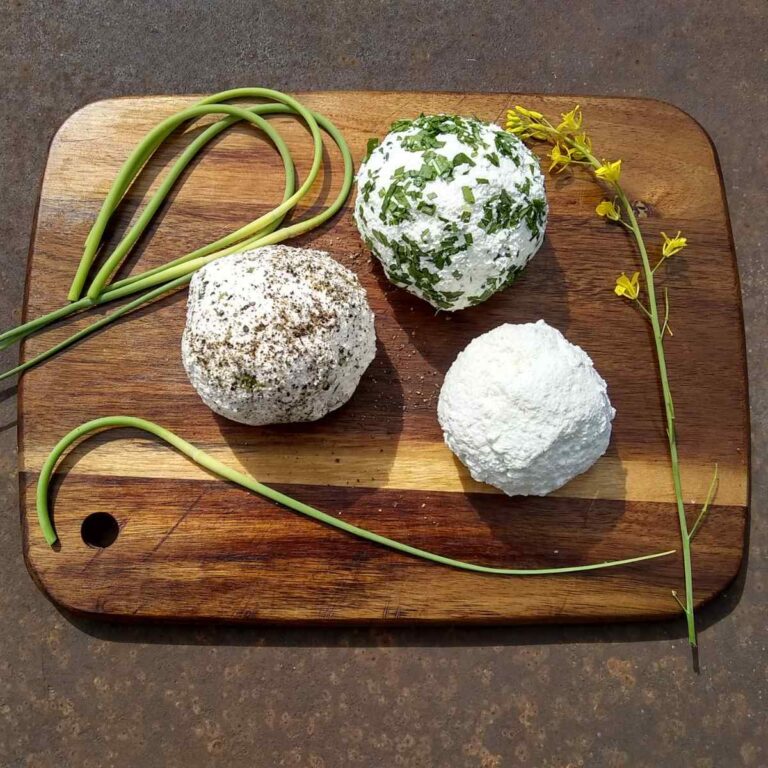

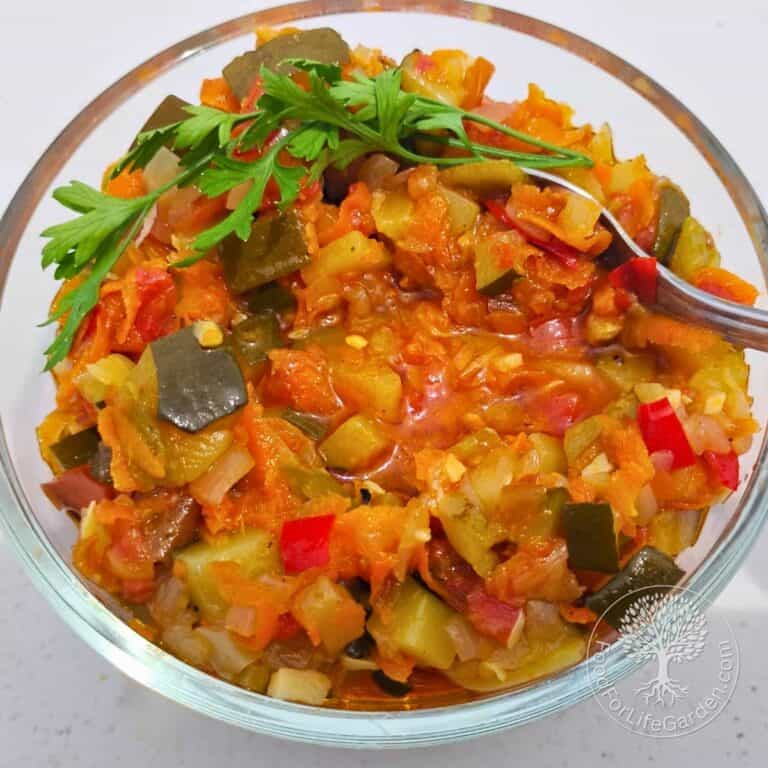
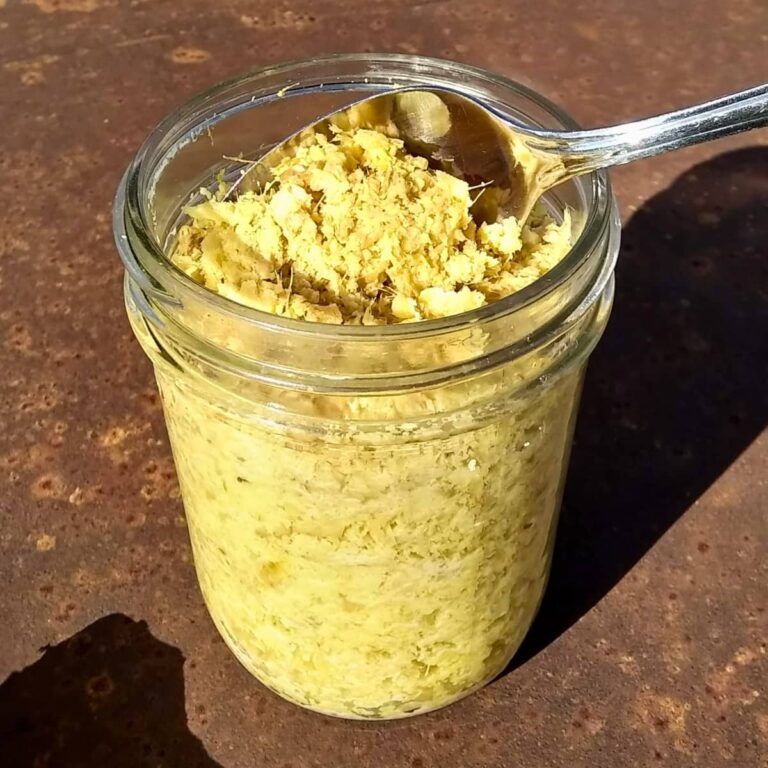

So good! Since it’s just me and my husband, we always have leftovers so I tried this recipe and glad I did.
That’s great Jasmin! Thank you so much for the positive feedback!
Giirrlllll!!! You are speaking my language! This looks ridiculously good!
Thanks, Penny! I appreciate your comment. It is crazy good!
Ohhh I think we will be making this for weekend dinner!
Awesome! I hope you’ll love it as much as I do!
Love this! My husband and I were reminiscing on our college days when we use to eat jambalaya from the box. So happy you shared this so we can get a healthier version of that to share with our kids!
Oh wow, I never even heard of jambalaya in a box! Thank you so much for sharing this!
YUM!! This looks fantastic, I love the combination of ham and shrimps, and all those amazing veggies and spices. Thank you so much for sharing this recipe.
You’re welcome! And thank you so much for commenting!
This looks delicious! I’m going to have to try this soon! Thanks for the inspiration!
You’re welcome, Tyla. I hope you get to try it and that you’ll love it!
I always wondered what jambalaya was! You see so many variations online you never really know what it is. Now I know why! This was a fun read, thanks for breaking it down 🙂
I’m unreasonably scared of seafood but ham and mushrooms are right up our alley 😉
Hey Sarah! Thank you so much for the comment, I’m glad I could help with the jambalaya jumble. I am a huge fan of seafood, but I can totally understand that not everyone cares for it. This dish is definitely delicious without the seafood too.
Ooooh, this looks so delish and nourishing! Thank you for this recipe – I can’t wait to try it!
Hey Margareta, Thank you so much for visiting and for your comment. I hope you get to try it and that you’ll love it!